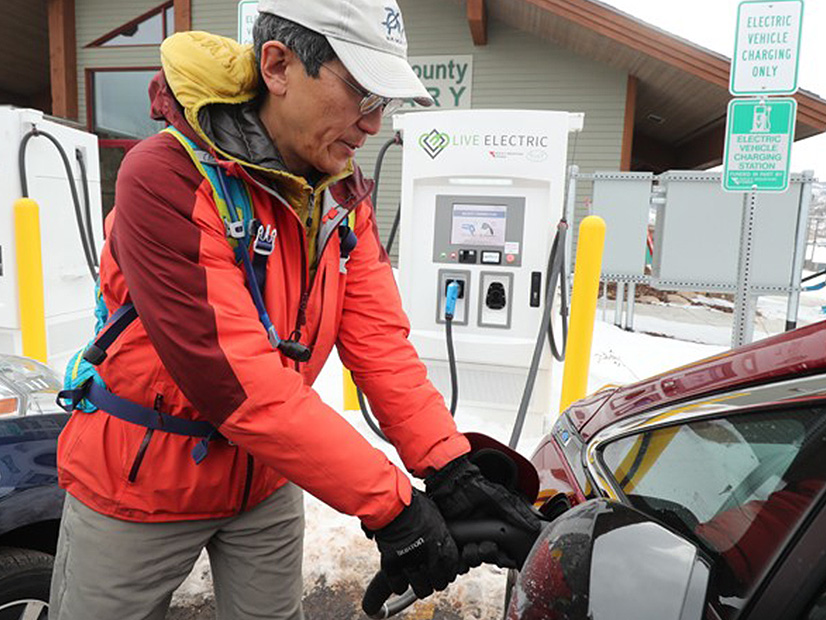
After spearheading an electric vehicle charging program that created two “electric highways” in Utah, PacifiCorp is using lessons learned to expand the project into six Western states, speakers said during a webinar last week.
PacifiCorp’s WestSmartEV program ran from 2017 to 2020. It involved installation of DC fast-chargers at 79 sites along I-15 and I-80. The program also included incentives for workplace installation of Level 2 chargers, a partnership with ride-share drivers, an EV car-share program for low-income residents and an electric bus project.
A second phase of the project, called WestSmart EV@Scale, is now underway. It will coordinate efforts to electrify over 42,000 miles of regional interstate and state highways in Utah, Washington, Oregon, Idaho, Nevada, Wyoming and Arizona.
The program’s focus includes underserved regions, urban mobility, freight and port electrification, and community and workplace charging.
Both programs received funding from the Department of Energy: $4 million for WestSmartEV and $6.6 million for WestSmart EV@Scale.
What Drivers Want
The webinar on Thursday was hosted by the National Renewable Energy Laboratory. James Campbell, PacifiCorp’s lead for the two programs, discussed lessons learned so far. Campbell is based at PacifiCorp’s Utah subsidiary, Rocky Mountain Power.
When deciding where to install DC fast chargers along I-15 and I-80, Campbell said it wasn’t quite as simple as drawing dots on a map every 50 miles.
Instead, he said, it was important to identify sites where drivers want to stop. For example, drivers weren’t that interested in a charging station in St. George, a retirement community near the Arizona border. Instead, they wanted to stop and charge in nearby Cedar City, a scenic highway access point.
And in a National Park component of the program, planners realized that many drivers travel from park to park on scenic highways rather than hopping on the interstate.
Co-location Benefits
Campbell said co-location of EV charging was a successful approach used in the programs.
One example is an electric-bus charging site in Park City, where there’s also charging for electric bikes and a few DC fast-charging stations. The co-location allowed infrastructure costs to be shared, Campbell said.
Uber and Lyft drivers also found the fast-charging stations, located about a mile off I-80, to be a convenient option on runs from the airport to Park City, one of their most lucrative routes.
Another way the approach can be used is through co-location of electric bus and train charging, Campbell said. As a train moves through the station and draws power, electricity to the buses can be turned down and then turned up again after the train has gone.
“That way you’re not creating these large peaks or these large demands,” Campbell said.
Unique Opportunity
Campbell described Utah as a unique opportunity for launching an EV charging program. When the first program started in 2017, the state had a very low EV adoption rate. But Campbell said there seemed to be latent demand as residents grew concerned about poor air quality, such as that seen in Salt Lake City in the winter.
The number of plug-in EVs registered in the state grew from 2,485 in 2017 to 12,522 in 2020, according to the final technical report on WestSmartEV.
The report also detailed results of the workplace charging project, which resulted in installation of 1,953 Level 2 chargers in the Salt Lake City area. A case study of EV charging at one company found that peak charging was between 7 and 10 a.m. Most charging was finished by 2 p.m., before the utility’s summer peak hours of 3 to 8 p.m.
“As a result, workplace charging is a preferred mode of charging for utilities,” the report concluded.
Another webinar speaker was Margaret Smith, technology manager in the DOE’s Vehicle Technologies Office. Smith said information gleaned from the projects would help states prepare for EV project funding opportunities from the federal Infrastructure Investment and Jobs Act.
“The insights and lessons learned from these projects are more relevant now than ever before,” Smith said.


